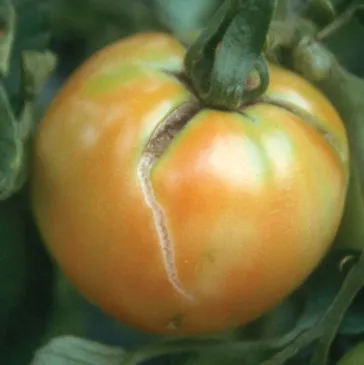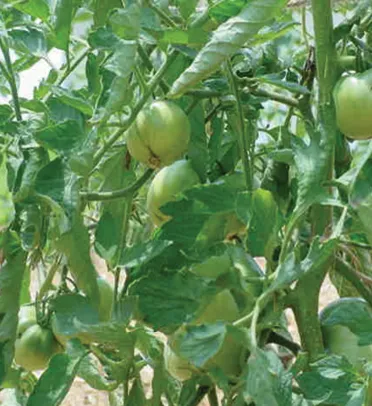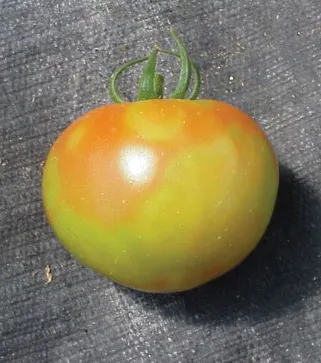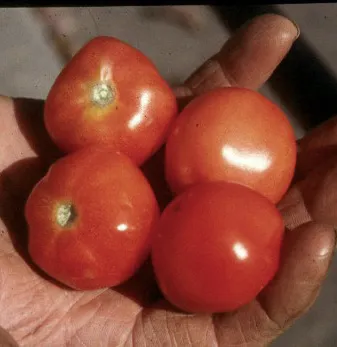What are some common problems with growing tomatoes?

Tomatoes are the most common produce grown in Mississippi, both in personal gardens and commercially. Not surprisingly, many questions arise from gardeners and commercial growers about various problems that occur during the season.
This paper highlights some of the most frequent disorders, preventative techniques, and further resources. Hopefully you will see very few, if any, of these situations in your own tomato plants this year.
Contents
Misshapen Fruit
Fruit that is misshapen is frequent in home gardens. There are several factors that cause misshapen fruit, but the most likely is low temperature.
If the temperature is above the mid-60s (°F), tomato fruit will grow the best form. Low temperatures result in ridged fruit (a rough shoulder) and catfacing (ugly bottom of fruit; see below). Planting later in the season, when temperatures are higher, can help to prevent some of these issues.
Certain cultivars are more prone to producing deformed fruit than others. Fruit of the larger beefsteak types as well as many of the older heirloom varieties are commonly misshapen.
Blossom-End Rot
Blossom-end rot (BER) is most likely the most frequent issue in all forms of production (home garden, field, and greenhouse). It appears as a dry, leathery (not mushy), dark brown or black area, usually at or near the bottom of the fruit. BER can sometimes occur on the side of fruit, and occasionally only on the inside, so the BER is hidden until the tomato is sliced open. The area is often sunken, and these tomatoes frequently mature before the rest.


BER is not a disease since it is not caused by an infectious agent (pathogen). It is a physiological condition induced by a shortage of calcium in growing fruit. Most Mississippi soils have enough calcium for tomato fruits to develop properly, but it is a good idea to have the soil tested to make sure.
A tissue analysis during the season can also help to identify nutritional deficiencies and help ensure that plants are absorbing needed nutrients for proper growth and development. Send samples of soil and tissue to the MSU Extension Soil Testing Lab ( http://extension.msstate.edu/agriculture/soils/soil-testing ) for examination. Visit the lab website for the most up-to-date fees and submission forms. Instructions on how to collect and submit soil and tissue samples are available in MSU Extension publications IS346 Soil Testing for the Farmer , IS1294 Soil Testing for the Homeowner , and P1224 Plant Analysis Sampling Instructions .
BER is often seen on the first tomatoes of the season. Although insufficient calcium in fruit is a contributing factor, the main problem is typically drought. Without a steady supply of water, the tiny root hairs dry out, which limits the amount of calcium the plants can absorb and supply to developing fruit. Let plants to droop between waterings. The easiest strategy to avoid root hair damage caused by drying out is to offer continuous water and mulch around plants.
Since tomatoes planted in containers tend to dry up more readily, BER may be particularly troublesome. To protect the roots, place mulch around the tomatoes. Certain cultivars are more vulnerable to BER than others. If the issue persists, try a new variety the next season.
It is crucial to emphasize that, although BER is not a disease, fungus are often seen as secondary infections on injured tissue. These fungi are often opportunistic, rather than pathogens that cause prevalent tomato illnesses. Also, BER is commonly mistaken with the illness buckeye rot, which causes brown, circular lesions on fruit. Buckeye rot lesions, in contrast to BER lesions, are generally oily and form concentric rings. Buckeye rot fruits are often found near to the ground. Publication 3175 has further information about buckeye rot. Common Diseases of Tomatoes .
Fruit Cracking
When growth circumstances are not ideal, cracking is a typical issue with tomatoes. Cracks can be described as radial—those that radiate from the stem end and move downward—and concentric—those that form rings around the stem end of the fruit.
Both sorts of fissures indicate that the plant’s water content is erratic. Uneven watering will cause fruit breaking, so make sure your plants receive adequate water. Cracking can also be promoted by very fast growth, excessive moisture (rain or heavy watering) after a dry period, high temperature, a large difference between daytime and nighttime temperatures, and inadequate nutrition.
Not all cracking can be avoided, but the severity can be lessened by mulching, maintaining an even water supply, and using an adequate fertilizer program. Certain kinds are also crack-resistant.

Catfacing
Catfacing is a condition in which the fruit becomes malformed or irregularly shaped, often with brown scars at the blossom end that sometimes run up the sides of the fruit. The fruit’s bloom end is often puckered with deep fissures. BER, on the other hand, appears as dark brown spots on the bottoms of fruit but without the puckering or fissures.
In its most severe form, the bottoms of fruit seem to be turned inside out so that the seed cavity is visible on the outside. It usually only affects the earliest fruit set due to the cooler temperature at that time; later-harvested fruit are generally not affected. Catfacing has no effect on the fruit’s edibility. The scars may be removed and the remaining tomato consumed.
Cool temperatures during pollination and early development are nearly invariably the cause of catfacing. Certain cultivars are more vulnerable than others. The only management methods are to plant later in the season, use resistant varieties, and use plastic or spun-bound row covers to increase temperature on cool days and nights.

Leaf Rolling
Leaf rolling is the term used for moderately or severely curled leaves, with the edges of leaves rolling inward. In extreme situations, the leaves are wrapped so tightly that they resemble green tubes. This is common after the plant has produced a large amount of fruit. Leaf rolling may also be caused by heavy pruning and damp soils. Leaf rolling usually starts on the older leaves, but it may infect the whole plant.
This condition is not harmful and should have no effect on production or fruit quality. Pruning less heavily and planting tomatoes in a well-drained area can help to reduce the occurrence of leaf rolling.

Yellowing of Leaves (Chlorosis)
Chlorosis, or leaf yellowing, can be caused by several factors. The most popular are as follows:
- Shading. As plants mature, the bottom leaves become heavily shaded and naturally turn yellow as they age. This does not imply that there is an issue with the plant. These fading leaves are no longer productive and should be removed to allow for better air circulation.
- Low nitrogen* or potassium*. If the nitrogen or potassium level in the plant is too low, yellowing will occur. Nitrogen deficit causes the whole plant to yellow, harming both old and young leaves. Potassium deficiency appears as bright yellow leaf margins, or edges, on otherwise green leaves. Potassium shortage mostly affects older leaves.
- Low magnesium*. In older leaves, low magnesium causes interveinal yellowing (yellowing between the veins). If you suspect magnesium deficiency, spray 2 tablespoons per gallon of magnesium sulfate (Epsom salt) on the plants. Watch to see whether they “green up” after a few days.
- Diseases. Several illnesses induce chlorosis, or leaf yellowing. This symptom is often associated with other symptoms such as leaf blotches or wilting. Publication 3175 has further information regarding illnesses. Common Diseases of Tomatoes .
*For any suspected nutritional issues, a tissue analysis is advised.

Uneven Ripening
Green stripes, streaks, or blotches; stars on the bottoms of fruit; and yellow or green shoulders are all signs of uneven ripening. Sometimes, one wall or one portion of the tomato will remain green or white even after the rest of the tomato turns red.
This problem may be caused by a number of factors, so the exact cause can be hard to determine. High fertility (typically nitrogen), low potassium, high temperature (the red pigment, lycopene, is destroyed at 93°F), infection with specific viruses, and sweetpotato whitefly feeding are the most probable culprits.
Maintain enough nutrition by conducting soil tests and applying fertilizer according to the recommendations. A tissue analysis can help reveal if the cause is nutritional. Visit the for assistance. MSU Extension Soil Testing Lab online and see Publication 1224 Plant Analysis Sampling Instructions .

Sunscald
Sunscald shows as a white or brown blistered region near the fruit’s top. This is comparable to sunburn in humans. In tomatoes, the affected area can turn leathery and be invaded by pathogens that cause rot, but it often remains dry.
To avoid sunscald, avoid heavy pruning, particularly at the plant’s crowns, and maintain optimum nutrition and pest control to offer excellent, leafy covering for the fruit.

Blossom Drop
Blossom drop occurs when flowers abort and fall from the plant rather than setting fruit. This has the potential to significantly diminish yield. Any sort of stress on the flower, including the following typical stressors, may impede fruit set:
- Too much nitrogen. Excess nitrogen often results in highly healthy-looking, lush, dark green plants with little flowers or fruit. This is the most common cause of stress by far, so be careful not to overdose tomatoes with fertilizer, especially early in the season before fruit set has occurred.
- High temperature. Pollen is sterilized at 93°F or above. Therefore, even though flowers are pollinated, they are not fertilized, so fruit will not develop.
- Low temperature. Temperatures below 55°F are less than ideal for floral set.
- Drought stress. Plants might wilt and shed their flowers as a result of a lack of water.
- Salt stress. When too much fertilizer is applied, the salt level in the root zone might rise to the point where it causes plant stress.

Notes
- Blossom drop is not caused by a lack of honey bees. Tomatoes are wind-pollinated and do not depend on bees, though bees do assist in pollination.
- Certain varieties are sold as “cold set” or “hot set” varieties and will set fruit more consistently at the designated extremes in temperature. Gardeners at home should see Extension Publication 3744. Mississippi Vegetable Garden Variety Suggestions for further details. Commercial growers can find heat-tolerant varieties recommended for Mississippi in the latest edition of the Southeast U.S. Vegetable Crop Handbook (available in print and at www.vegcrophandbook.com ).
Small Fruit
Little fruit is less disturbing than no fruit, but it may still be a major issue. Beefsteak sizes range from less than a half-pound to well over a pound. Cherry and grape tomatoes are substantially smaller in size.
These are possible causes of undersized fruit:
- Lack of water.
- High temperature. This is a prevalent condition in the hot, humid Southeast from late spring through early October.
- Shading. Be sure that huge trees or buildings do not cast too much shadow on the plants.
- Mislabeled plants. Tomato sizes vary by variety. Although rare, plants are sometimes mislabeled during greenhouse production and sold under the wrong name.

The material provided here is only for educational purposes. References to commercial products, trade names, or suppliers are made with the understanding that no endorsement is implied and that no discrimination against other products or suppliers is intended.
Publication 2975 (POD-12-22)
Revised by Rebecca A. Melanson , Central Mississippi Research and Extension Center Associate Extension Professor of Plant Pathology, and Christine E. H. Coker Professor of Research and Extension at the Coastal Research and Extension Center. Originally prepared by Richard Snyder, PhD, Extension/Research Professor, Central Mississippi Research and Extension Center.





